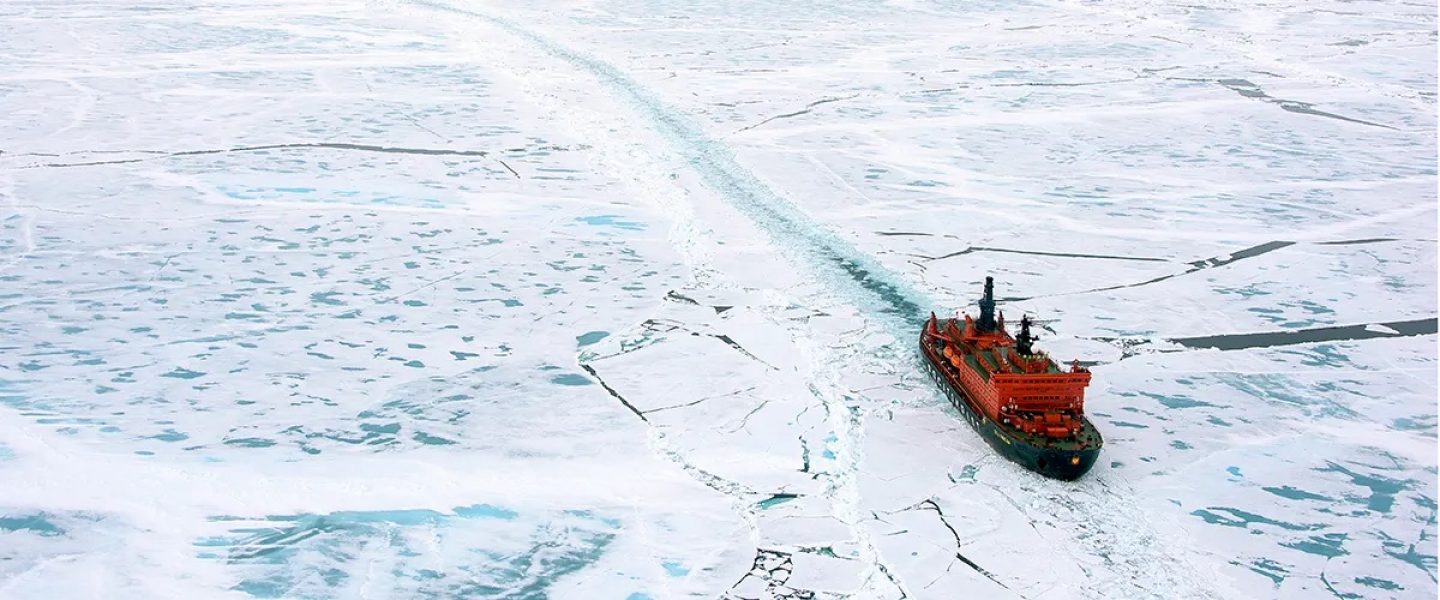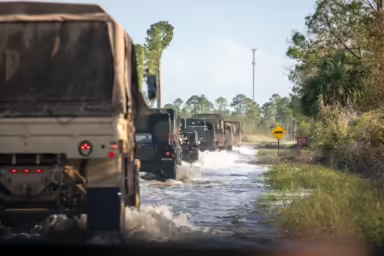Climate science and the global shipping industry collide in an ice-poor Arctic.
|
Listen To This Story
|
Controversy over shipping routes in the Arctic Ocean is intensifying in light of recent climate science projections of sea ice melt. By midcentury, ice-free routes in international waters once covered by summer sea ice may appear for the first time in recent history, according to new research. A more accessible Arctic could influence the timing, sustainability, and legal status of international shipping.
Diverting ships from their original routes — often from the Panama or Suez canals — could reduce transit time and distance for many international journeys. And a small subset of shipping routes could significantly slash their greenhouse gas emissions if rerouted through the Arctic.
Sea ice extent may even influence the reach of international law: At present, Article 234 of the United Nations Convention on the Law of the Sea grants coastal countries regulatory power over areas that are ice-covered for most of the year. Although opinions differ, some have said shrinking sea ice could limit countries’ claims in the Arctic Ocean.
“The unfortunate reality is that the ice is already retreating, these routes are opening up, and we need to start thinking critically about the legal, environmental, and geopolitical implications.” — Amanda Lynch
“There’s no scenario in which melting ice in the Arctic is good news,” said climate scientist Amanda Lynch from Brown University. “But the unfortunate reality is that the ice is already retreating, these routes are opening up, and we need to start thinking critically about the legal, environmental, and geopolitical implications.”
The extent of Arctic melt depends on how warm the world gets. Scientists have warned that heating Earth far beyond 1.5 C (2.7 F) will have disastrous, deadly consequences.
Shifting Seas
Pandemic supply chain interruptions and the Russian invasion of Ukraine have highlighted the delicate flow of global goods.
To some, the warming Arctic presents an opportunity for trade: Funneling ships through the Arctic Northern Sea Route is 30 percent to 50 percent shorter than taking the Suez Canal, according to a 2021 review of international shipping. Travel time could drop by more than 2 weeks, depending on vessel speed.
Diversions “will have a low impact on global emissions.” — Zhaojun Wang
Those looking for a climate-friendly reason for Arctic shipping may be disappointed, however.
Zhaojun Wang at the Smithsonian Environmental Research Center, who conducted research on Arctic shipping while a doctoral student at the University of Delaware, found that diverting a small subset of global shipping trips reduced their emissions by an average of 24 percent, conserving about 264 metric tons of fuel each.
But those trips make up only a tiny fraction of shipping journeys: Only 20 of more than 500,000 international trade trips save money and time by taking the Arctic route. These diversions “will have a low impact on global emissions,” said Wang. She published the results in the Maritime Policy and Management journal last year.

According to new results in the Proceedings of the National Academy of Sciences of the United States of America (PNAS), shrinking ice could affect the fingerprint of Arctic law. Sea ice is preferentially retreating from the eastern Arctic near Russia.
“The sea ice diminution means that the state of Russia will not be able to make the same level of claims, at least not lawfully, across the waters,” said Charles Norchi, director of oceans and coastal law at the University of Maine School of Law, who participated in the new study. “What we have is the law and the geopolitical relationships really being driven by the science of climate change.”
But Arild Moe, a research professor at the Fridtjof Nansen Institute in Norway who co-authored the 2021 analysis of the Northern Sea Route, contended that Russia may retain control of traffic even when sea ice vanishes. “I do not see a reduction in regulatory friction.”
Thin Ice
There are many types of ships that might take advantage of ice-free waters in the future: naval vessels, cruise ships, container ships, scientific vessels, and transport ships to offshore drilling platforms.
“Diversifying trade routes — especially considering new routes that can’t be blocked, because they’re not canals — gives the global shipping infrastructure a lot more resiliency.” — Charles Norchi
These ships would have to contend with myriad challenges in an increasingly ice-free Arctic. One of the most prominent is the fact that ice in the Arctic will vary drastically year to year. “Regardless of which climate change scenario path we’re on, interannual variability remained very high for a long period,” said Lynch, who led the latest PNAS study.
Although 83 of more than 500,000 trips were shorter and 45 saved sailing time in Wang’s sustainability analysis, only 20 were economically feasible. “We definitely think that’s a surprising result, because people always talk about the Arctic as having great potential for shipping.”
Complications don’t stop there: It’s difficult to get Arctic satellite navigation coverage, the ice is hard to forecast, emergency operations are challenging, and shipping has various restrictions under the Polar Code, which limits the sizes of vehicles allowed. Wang has worried about the effects of invasive species on the fragile Arctic environment, too.
“Even if there could be some shippers preferring trans-Arctic navigation, others might not,” said Moe. “Risk assessments and insurance are key here.”
But Norchi pointed out the possible benefits of diversifying shipping.
“Diversifying trade routes — especially considering new routes that can’t be blocked, because they’re not canals — gives the global shipping infrastructure a lot more resiliency,” Norchi said.




